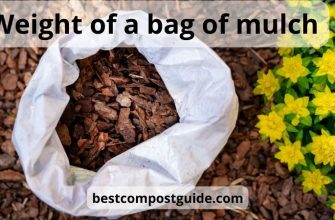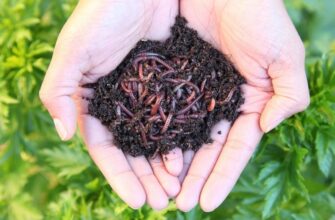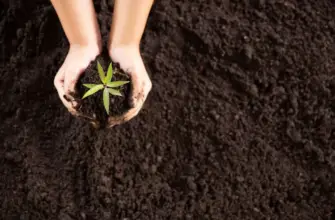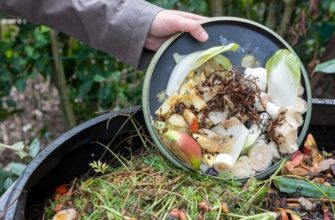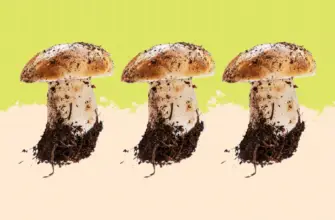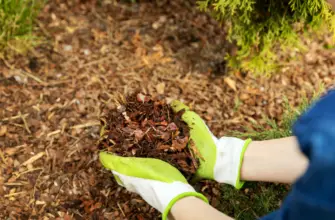Many gardeners wonder, can you compost weeds? As a result of long experiments, it was proved that this can be done. However, you need to do everything right so as not to harm the garden. You can read more details about composting weeds in this article.
- Weed varieties
- Perennial weeds
- Biennial weeds
- Annuals
- Can dried weeds be used in the compost?
- Can weeds treated with herbicide be used?
- Can we add weeds to the compost?
- Can we add weeds to a compost bin?
- Preventing weeds in the compost
- Versatile composting weeds methods
- Drying or roasting weeds
- Composting in water
- Hot composting
- Formation of hot compost: rules
- Drying grass clippings in the sun
- The right place for a compost
- Where to place?
- Compost turning
- Composting weeds with seeds
- Composting a lot of weeds
- Duration of weed decomposition
- What should you not put in compost?
- Products and other things
- Results
Weed varieties
Before proceeding to the question of whether can you compost weeds, you should decide on the main types of weed seeds. In total, there are several types. Below, you can read about types of weeds in a compost.
Perennial weeds
Perennial weeds that die after a long time are in particular demand among gardeners. The category of perennial weeds includes dandelions, wheatgrass, sorrel, couch grass, and creeping buttercup. Perennial weeds in a compost are suitable types.
Biennial weeds
This category of garden plants is different in that it dies 2 years after planting in garden soil. It includes evening primrose, common mullein, burdock, etc.
Annuals
The peculiarity of such garden plants is that they die in the first year after planting in garden soil. This category includes mountaineer, ragwort, a variety of bindweed, couch grass, mallow, etc.

Can dried weeds be used in the compost?
If necessary, you can add already dry compost weeds. If you are preparing it during the warm season, spread the grass clippings over the metal surface. Leave to dry even the toughest weeds
completely in the sun. On average, this takes several weeks.
Once the weeds are dry, they can be added to the compost. Some gardeners prepare a wire mesh structure for drying. This is a fairly budget option for a fixture that is easy to find at home.
Can weeds treated with herbicide be used?
If you have controlled weeds with herbicides, their use is highly controversial. It must be understood that even the highest quality herbicides are not always able to destroy seeds.
At the same time, the chemically treated weeds can block the development of beneficial microorganisms in the compost.
The action of herbicides is different. Some compounds destroy the weed, however, do not kill the weed seeds. Over time, the weed seeds begin to germinate in the compost, so it does not be possible to use them on the site. If you use compounds that destroy weed seeds and grass, they can make the compost too toxic.
It is best to keep a few weeds that have been treated with herbicides away from the compost. This prevents the weed seeds from spreading around the yard. If you want to add the treated grass to the compost, then it can only be applied to those plants that are not sensitive to herbicides.
Can we add weeds to the compost?
You can add grass to your compost if you plan on sticking with the hot composting method. It is important to provide adequate care for the compost so that the temperature can kill the seeds. If you prepare the compost using the cold method, it is better to refuse weeds.
You can also kill weeds before adding them to the compost. Place the weeds in a container that has an airtight lid. Fill with water and close the container.
You must wait a few weeks. The water takes on a greenish-brown hue and is saturated with nutrients. It can be used to water weeds.
Can we add weeds to a compost bin?
If you have a compost tumbler, you can add some weeds to it. However, you need to constantly maintain a high temperature. However, this is quite easy to do in a tumbler because it produces heat well and retains it.
Drying and soaking of weeds are allowed. Only then can they be added to the compost to make it safe for weeds.
Preventing weeds in the compost
Using compost that contains weeds can damage the site. After all, grass can spread uncontrollably throughout the territory, and you have to constantly clean it.
However, such situations do not always arise. If you properly prepare weeds for compost and care for them properly, you can create a nutritious mass.
It is better to pay attention to weeds, which contain a lot of nutrients. This category includes nettle, ranunculus, and wheatgrass.

Versatile composting weeds methods
There are several ways to compost weeds. These include:
- drying in the sun;
- composting weeds in water;
- composting weeds in the process of heating.
You can read about each method of composting weeds in more detail below.
Drying or roasting weeds
Many people ask, can you compost weeds with roots? Weeds are best dried or baked in the sun. If the weather does not allow this, you can use the oven. Roasting is carried out until the seeds and roots of plants are destroyed by heat.
This prevents seed growth and root sprouting, which can happen if it gets into the compost heap. To speed up the process, you can put the weeds in a bag. This increases the heat, which will destroy the seed.
Composting in water
If you need to take out the nutrients from the weeds, you can soak them in water. On average, the fermentation process should last about 21 days. During this time, the water will absorb the nutrients from the weeds.
The water that has been infused can be used as a liquid fertilizer for plants. Leftovers of the liquid fertilizer can be added to compost. To create liquid compost, fill half the container with weeds, and pour water to the very top. After the container is covered with a lid.
The prepared solution cannot be used in its pure form. After all, it is too concentrated; therefore it can burn cultivated plants on the site. The solution must be slightly diluted with water.
Hot composting
The essence of this method is that weeds are added to a compost pile or compost bin. The temperature must be quite high. Do not forget to periodically turn the compost pile to increase the release of heat.
Formation of hot compost: rules
Hot composting is an excellent option for perennial weeds that have a highly developed root system. The essence of the hot composting method is to add grass clippings to a heated compost pile.
Hot compost is prepared in special automatic composting plants. You can also use your local compost bin, which is made from a plastic trash can. There are several steps to go through when making hot compost weeds.
Drying grass clippings in the sun
You first need to dry perennial crops. The sun would be a great option for this. The procedure is necessary to destroy viable roots that can germinate in the compost under favorable conditions.
When the compost weeds killed in the sun, the roots begin to die off. If you add grass to your hot compost, it won’t germinate.
The right place for a compost
The next step is to place the compost bin in favorable conditions.
Where to place?
Pick a spot in your backyard. Make sure that there is no shade from plants or buildings in this place.
The basket must be placed on a flat surface, which is well-lit by the sun all day. You should also make sure that you have a good ventilation system. Due to a properly selected place, a sufficient amount of heat is generated. Air must be allowed to enter the compost to speed up the decomposition of weeds.
You can then add weeds inside the compost bin. Once the first layer of hot compost weeds has been added, you can start adding the green parts. Add brown and green weeds by alternating.
Weed concentration should be deeper in the center. It is this area of high temperature that provides the highest rate of decomposition. Even if the roots germinate, compost weeds killed at the high temperature.
Compost turning
To generate heat and increase airflow rates, try to turn the compost heap over every week. This can be done with a rake, fork, or shovel.
If you are working with weed compost, other materials should be discarded. It is best to add all the available waste at once, and then cover them. This helps the compost to break down better.
Composting weeds with seeds
If there are weeds in the area that have begun to produce seeds, and you plan to use them in the preparation of compost, as already mentioned, they must first be dried in the sun. This contributes to the destruction of not only seeds but also existing pathogens.
You can also soak weeds in the form so that they are infused for a month. Weeds that start to rot can be added to the compost bin. This will destroy the seeds so that they do not germinate in the compost and fall into the area where crops grow.

Composting a lot of weeds
Many people wonder what to do with piles of weeds. If you have a whole bunch of grass clippings and don’t know what to do with them, you can make quality compost. It is advisable to prepare large black plastic bags for composting process. They are often used for garbage.
This allows you to compost the grass clippings alone so that they cannot enter the site later. The composting process in plastic bags is quite simple.
First, you need to fill the bags with composting weeds. Add some earth and water to each bag. Tie the bags tightly, and take them to the farthest barn so that they do not interfere. You need to leave grass clippings there for 1-1.5 years. You can then open the bags and use the nutritious compost to maintain your garden.
Duration of weed decomposition
Quite often, people wonder how long it takes for weeds to fully decompose. It is impossible to say the exact time. The process to kill weeds depends on the composting method.
Drying weeds in the sun for a few weeks, or soaking them in water for months, can destroy the root system and seeds. However, destruction should not be expected. If the compost is kept between 115 and 140℉, it kill weeds almost 90%.
However, all of the above methods do not be fully compostable. Weeds cannot remain viable after drying, soaking, or baking. However, they need sufficient time to decompose. The exact time depends on which composting method you choose: cold or hot.
The rate of decomposition also depends on other factors, including the type of organic matter that has already been added to the compost. You should also consider what containers are used: a bucket, a drum, or a pile. You should also pay attention to whether you are using large or chopped weeds.
If you compost weeds in plastic black bags, it will take 1-2 years to fully compost them. It all depends on the climate in your area. The hotter the climate, the faster the composting process will complete.
What should you not put in compost?
Quite often, gardeners wonder what products should not be added to compost.
Products and other things
This category includes:
- meat or fish waste;
- milk and dairy products;
- oil and fat;
- plants that have been treated with pesticides or other chemicals;
- black walnut wood;
- plants that have been infected with diseases or parasites;
- germinated weeds;
- coal ash;
- the excrement of cats and dogs.
Results
As you can see, weeds can be added to the compost. However, you need to do this correctly so that they do not germinate and do not fill the entire area with themselves.
Read also: Disadvantages of composting, and how to benefit from it?


